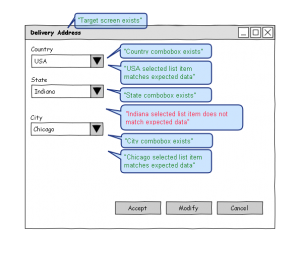Basic Test Flow: GUI Screen Verification
GUI Screen Verification Test Flow
Entry/Exit Points
Entry Point. Single. GUI screen (window, web page, etc.).
Exit Point. Single. Same GUI screen.
Operations
GUI interaction – None
GUI observation
- checking screen (windows, web pages, etc.) in context of which GUI objects are checked
- checking GUI objects (exist, enabled, etc.)
- check GUI objects’ data (text displayed, item selected, etc.)
Evaluation – assessment of Pass/Fail criteria for GUI observations.
Pass/Fail Criteria
Fail Criteria
- GUI observation failure
- Assessment criteria failure
Stop Criteria
- GUI context not available
- End of steps reached
Pass Criteria
- No failures
- End of steps reached
Test Data
Input Data. None.
Verification Data. The Test Flow uses verification data to check GUI objects’ actual data. Verification Data could be hard-coded or combination of hard-coded and parameterized data.
Example
1. GUI observation. “Target screen exists”.
2. GUI observation. “Country combo box exists”.
3. GUI observation. “USA selected list item matches expected data”.
4. GUI observation. “State combo box exists”.
5. GUI observation (evaluation failed). “Indiana selected list item does not match expected data”.
6. GUI observation. “City combo box exists”.
7. GUI observation. “Chicago selected list item matches expected data”.
Commentary
GUI Screen Verification test flow is static: no interactions with application under test required. It consists of a sequence of simple observations and assertions.
Note the scope of the Flow is limited to verification of those GUI objects and those their properties that are explicitly defined. For instance, “Accept”, “Modify”, or “Cancel” buttons presented on the GUI screen, will not be noticed or verified by a script executing the test flow.
Implementation
Most of automation tools offer a “native” static verification mechanism, called a Checkpoint. Checkpoint may use hard-coded or parameterized Test Data.
Coverage
The Coverage is in direct dependency on the number of GUI objects and their properties enlisted for verification. However, the bigger the number of objects enlisted in a checkpoint, the higher its maintenance cost. Maintenance cost grows exponentially.



